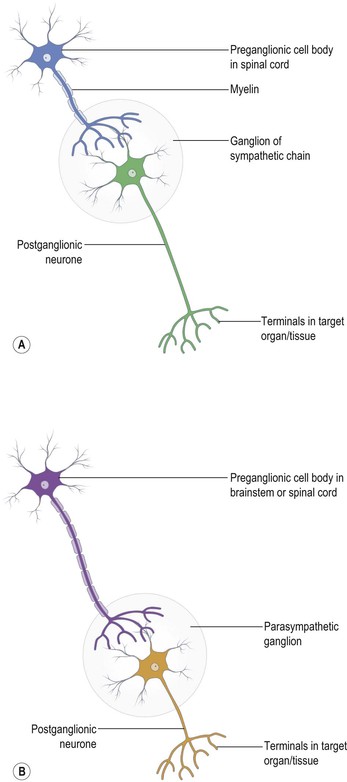Autonomic nervous system
The term ‘autonomic nervous system’ is used to describe those nerve cells located within both the central and peripheral nervous systems that are concerned with the innervation and control of visceral organs, smooth muscle and secretory glands. The principal function of the autonomic nervous system can be broadly described as the maintenance of the internal environment, or homeostasis. This is achieved by regulation of cardiovascular, respiratory, digestive, excretory and thermoregulatory mechanisms, which occurs automatically and with relatively little volitional control.
Autonomic afferent and efferent nerve fibres enter and leave the CNS through spinal and cranial nerves. Within the spinal cord and brainstem, they establish interconnections through which autonomic reflexes are mediated. Afferent fibres also establish connections with ascending neurones through which conscious awareness of visceral functions is achieved. Changes in the internal and external environments, and emotional factors, profoundly influence autonomic activity, most notably via descending connections from the hypothalamus (Ch. 16). Autonomic efferent neurones differ from those of the somatic nervous system in that, in the autonomic nervous system, there is a sequence of two neurones between the CNS and the innervated structure (Fig. 4.1). The synaptic connection between the two neurones is located peripherally in an autonomic ganglion. The first neurone is, thus, called the preganglionic neurone and its cell body is located in the spinal cord or brainstem. The second neurone is referred to as the postganglionic neurone and its cell body is located peripherally in an autonomic ganglion.
The efferent neurones of the autonomic nervous system fall into two distinct anatomical and functional divisions or systems: namely, sympathetic and parasympathetic. Many, although not all, structures that receive autonomic fibres are dually innervated by both sympathetic and parasympathetic systems. These exercise opposite effects upon the innervated structure (Table 4.1).
Table 4.1
Functions of the autonomic nervous system
| Structure | Sympathetic effect | Parasympathetic effect |
| Iris of eye | Dilates pupil | Constricts pupil |
| Ciliary muscle of eye | Relaxes | Contracts |
| Salivary glands | Reduces secretion | Increases secretion |
| Lacrimal gland | Reduces secretion | Increases secretion |
| Heart | Increases rate and force of contraction | Decreases rate and force of contraction |
| Bronchi | Dilates | Constricts |
| Gastrointestinal tract | Decreases motility | Increases motility |
| Sweat glands | Increases secretion | |
| Erector pili muscles | Contracts |








